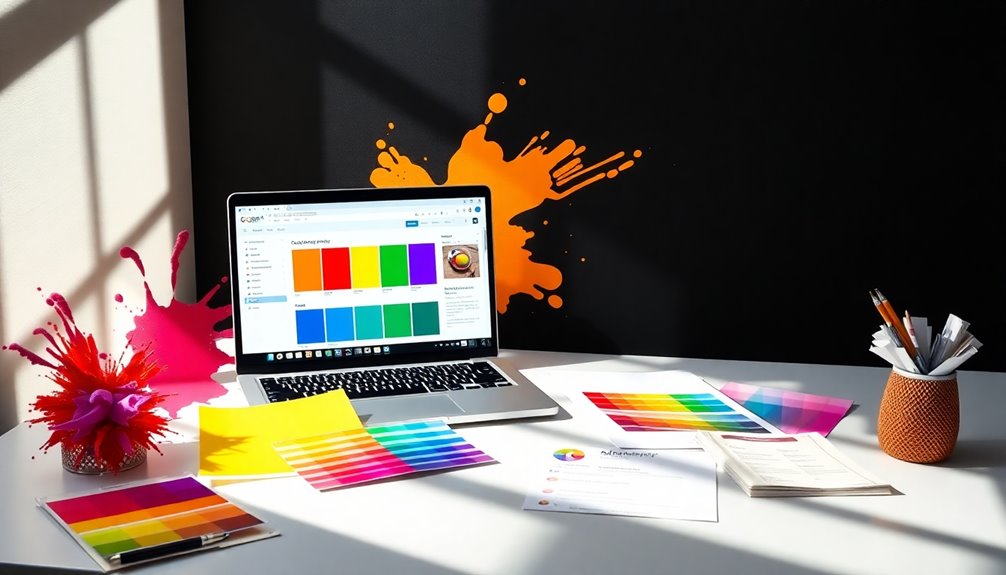When designing for accessibility, you need to pay close attention to color choices and contrast ratios. Following WCAG guidelines, aim for a minimum contrast ratio of 4.5:1 for normal text and 3:1 for large text. This guarantees readability for all users, especially those with visual impairments. Use online tools to test your color combinations and consider issues like text over background images. Keep going to discover best practices and strategies to enhance your designs further.
Key Takeaways
- Ensure a minimum color contrast ratio of 4.5:1 for normal text and 3:1 for large text to enhance readability.
- Utilize high-contrast color combinations to improve visibility for users with visual impairments or color blindness.
- Test color choices with tools like WebAIM Contrast Checker to ensure compliance with WCAG guidelines.
- Avoid embedding text in images to maintain clarity and readability for all users.
- Implement solid or semi-transparent overlays on background images to enhance text legibility and accessibility.
Why Color Accessibility Matters

Why should you care about color accessibility? It's vital for creating an engaging and effective web experience for all users, especially those with visual impairments or color blindness.
Adhering to WCAG guidelines guarantees that your design choices incorporate adequate contrast, making content readable and navigable. With around 8% of men and 0.5% of women experiencing color blindness, considering inclusive color combinations becomes important.
Poor contrast can alienate users, creating barriers that hinder their ability to interact with your content. By limiting your color palette to pre-approved, accessible options, you not only comply with accessibility standards but also enhance your brand's consistency.
Prioritizing color accessibility means you're actively making your website more inclusive and user-friendly.
WCAG Color Contrast Requirements

Color accessibility goes beyond just choosing the right hues; it involves adhering to specific guidelines that guarantee all users can read and interact with your content.
The WCAG standards specify a minimum color contrast ratio of 4.5:1 for normal text and 3:1 for large text, ensuring readability for individuals with visual impairments. For AAA compliance, you should aim for a 7:1 ratio for normal text, highlighting the need for accessible color choices.
Non-text elements like buttons need a minimum contrast ratio of 3:1 as well. While decorative elements and inactive components can have relaxed requirements, following these design principles is essential.
Utilize accessibility tools to check contrast ratios and create an inclusive experience for all users.
Elon University's Color Management in the CMS

At Elon University, the Content Management System (CMS) offers a set of accessible color options that guarantee compliance with accessibility standards.
By sticking to pre-approved colors, you help maintain brand consistency while avoiding potential violations.
If the standard palette doesn't work for your needs, reach out to the Online Communications Team for support.
Accessible Color Options
While maintaining accessibility standards can seem challenging, Elon University's Content Management System (CMS) simplifies the process by offering a selection of pre-approved, accessible color options.
These options guarantee compliance with WCAG guidelines for color contrast, enhancing the user experience for individuals with visual impairments. By prohibiting custom colors, the CMS promotes a cohesive visual identity while maintaining accessibility.
When using background images, make certain your text meets specific contrast requirements; consider solid or semi-transparent overlays for improved readability.
Avoid modifying HTML markup, as it can compromise accessibility. If you need additional color options or assistance, reach out to the Online Communications Team, who can help you explore accessible alternatives within the CMS framework.
Brand Consistency Assurance
Guaranteeing brand consistency is essential for maintaining Elon University's visual identity, and the Content Management System (CMS) plays a key role in this effort.
The CMS restricts color choices to pre-approved options that comply with the Web Content Accessibility Guidelines (WCAG) 2.1 AA standards for contrast ratio. This practice not only upholds Elon's branding but also enhances visual appeal for all users, including those with visual impairments.
Custom color modifications are prohibited to guarantee accessibility and consistency. If the available palette doesn't meet your needs, you can always reach out to the Online Communications Team for assistance.
Compliance With Accessibility Standards
To maintain a commitment to inclusivity, Elon University's Content Management System (CMS) enforces strict compliance with accessibility standards by limiting color options to pre-approved choices that meet WCAG 2.1 AA guidelines. Custom color modifications are prohibited to guarantee consistency and accessibility. All approved color combinations are tested for adequate contrast, supporting users with visual impairments and color blindness. If the options don't meet your needs, you can contact the Online Communications Team for assistance. Editing HTML directly is discouraged, as it may lead to unintentional accessibility violations, affecting readability for users with low vision.
| Color Combination | Contrast Ratio | Accessibility Status |
|---|---|---|
| Black on White | 21:1 | Compliant |
| Dark Blue on Yellow | 8:1 | Compliant |
| Grey on White | 4.5:1 | Non-Compliant |
| Red on White | 3:1 | Non-Compliant |
| White on Black | 21:1 | Compliant |
Best Practices for Using Colors

When you're choosing colors for your design, always prioritize high contrast combinations to boost readability.
It's essential to follow color usage guidelines, ensuring that everyone can access your content, regardless of their visual abilities.
Don't forget to test and validate your choices with tools that check for accessibility compliance.
High Contrast Combinations
While creating an accessible design, using high contrast color combinations is essential for enhancing readability, especially for users with visual impairments.
Aim for a minimum contrast ratio of 4.5:1 for regular text and 3:1 for large text, as outlined by WCAG 2.1 standards.
Utilize complementary colors from the color wheel to achieve visually striking contrasts that improve text legibility.
When placing text over background images, guarantee adequate color contrast by using solid or semi-transparent overlays to meet accessibility requirements.
Don't forget to employ tools like the WebAIM Contrast Checker to evaluate your color combinations and verify they align with necessary contrast ratios.
Consistent high contrast enhances both accessibility and your website's visual identity.
Color Usage Guidelines
Color plays an essential role in design, not only for aesthetics but also for guaranteeing accessibility.
To enhance color contrast, adhere to WCAG 2.1 AA standards, maintaining a minimum ratio of 4.5:1 for regular text and 3:1 for large text.
Avoid using color as the sole means of conveying information; always include text labels or icons for users with visual impairments, including color blindness.
Consider employing solid or semi-transparent overlays on background images to improve legibility.
Stick to CMS-provided color palettes to guarantee compliance, as custom colors can violate contrast standards.
Regularly test your color combinations with contrast checkers to assure an inclusive design that accommodates all users effectively.
Testing and Validation Methods
To guarantee your designs meet accessibility standards, effective testing and validation methods are key.
Start by using online tools like the WebAIM Contrast Checker and A11y Colour Contrast Table to confirm your color choices align with WCAG's minimum contrast ratios of 4.5:1 for normal text and 3:1 for large text.
Conduct A/B testing on various color combinations to find options that maintain sufficient contrast and enhance readability.
Don't forget to test your designs in grayscale to evaluate contrast for users with monochromatic vision.
Incorporate solid or semi-transparent overlays on background images to improve text legibility.
Regularly review and validate your color selections against accessibility guidelines to create an inclusive design that caters to users with visual impairments or color blindness.
Considerations & Warnings

As you enhance accessibility through design, it's important to take into account potential pitfalls that can undermine your efforts. Custom HTML modifications might bypass built-in safeguards, risking WCAG violations. Beware of text over background images; poor color contrast can lead to accessibility issues. Always layer text on compliant backgrounds to maintain readability for users with visual impairments.
Here's a quick reference table to help you avoid common mistakes:
| Issue | Impact on Accessibility | Recommendation |
|---|---|---|
| Custom HTML modifications | Violates WCAG standards | Use built-in styles |
| Text over background images | Poor contrast | Layer text on compliant backgrounds |
| Hidden links and buttons | Hinders navigation | Guarantee visibility from surrounding content |
| Embedded text in graphics | Reduces readability | Avoid embedding text |
| Non-standard link styles | Impairs accessibility | Stick to pre-approved CMS styles |
Final Thoughts on Color Accessibility

While it might seem easy to overlook, prioritizing color accessibility is essential for creating an inclusive digital experience.
With around 8% of men and 0.5% of women experiencing color blindness, you need to guarantee your designs meet WCAG standards. Contrast is essential; a minimum ratio of 4.5:1 for normal text can greatly enhance user experience.
Poor color contrast can make content illegible for millions with vision impairments, limiting your audience. By incorporating alternative cues and using tools like the WebAIM Contrast Checker, you can create visually appealing designs that are accessible to all users. Additionally, understanding the nutritional benefits of proper hydration can help maintain focus and clarity while designing.
Frequently Asked Questions
Why Is Color Contrast Important for Accessibility?
Color contrast is essential for accessibility because it directly affects how easily you can read and interact with content.
If you're moving through a website or app, poor contrast can make text hard to read, leading to frustration.
High contrast guarantees that you and others, including those with visual impairments, can engage with the material without straining your eyes.
Ultimately, better contrast enhances your overall experience and makes information more accessible for everyone.
What Is Color Accessibility in Design?
Color accessibility in design means ensuring that everyone, especially those with visual impairments or color blindness, can easily read and understand visual content.
You should focus on maintaining the right contrast ratios between text and background colors to enhance visibility.
What Does Color Contrast Help Achieve in a Design?
Color contrast helps you achieve better text legibility and enhances overall user experience. By ensuring a clear distinction between text and background elements, you guide users' attention and make navigation easier.
It reduces eye strain, making content more enjoyable to read. With effective contrast, you create a visual hierarchy that highlights important information.
Plus, it makes your design more accessible for everyone, including those with vision impairments or color blindness.
Why Is Color Contrast Important in Designing for Inclusion?
Color contrast is essential in designing for inclusion because it guarantees everyone can access and understand your content.
When you use high-contrast colors, you make it easier for individuals with visual impairments or color blindness to navigate and comprehend information.
This not only broadens your audience but also fosters a sense of belonging.
Conclusion
In summary, prioritizing color accessibility isn't just about meeting guidelines; it's about creating an inclusive experience for everyone. By understanding the WCAG requirements and implementing best practices, you can enhance your designs and guarantee that all users can engage with your content comfortably. Remember to stay aware of color management strategies, and don't hesitate to seek feedback. Together, we can make the digital world more accessible and welcoming for all.









